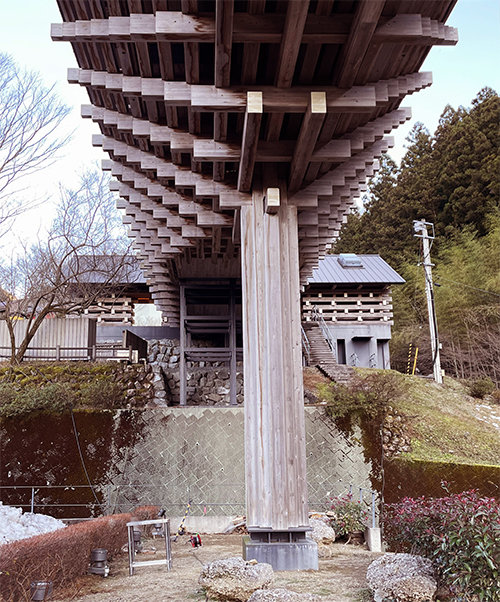
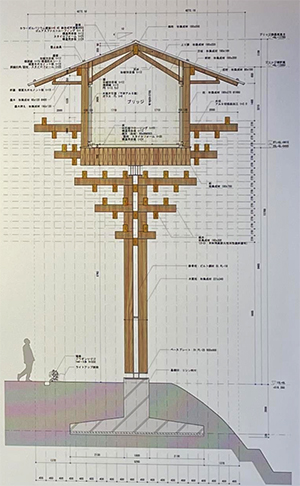
この木橋ミュージアムの現場パネル展示にあった説明文に、隈研吾氏の建築への解説が書かれていたのだけれど、表現はちょっと難解。
「刎木(はねき)が重なり合う「斗栱〜ときょう」という伝統表現をオーバードライブして作られる全体は「木の組積造」とも呼ぶべきものとなり、軸組形式では得られない存在感(具体性)と抽象性を醸し出している。」
・・・これでは説明文にさらに説明が必要で、それも図解入りが必須のようです。
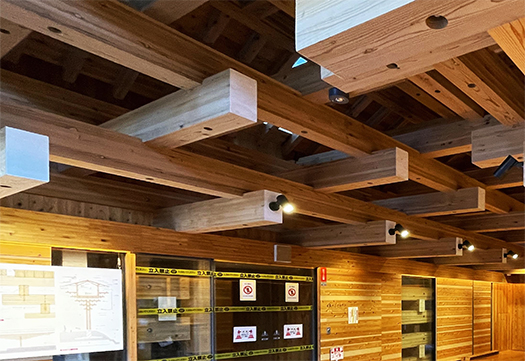
写真で示すならこの写真が斗栱になるようです。柱の最上部や軸部の上に設置され、軒桁を支える部位。たしかに「木の組積造」という表現がふさわしいし、こういった架構が通常の軸組木造とは違うイメージを見る者に与えることはよくわかる。斗栱という架構技術は広義では社寺建築などに一般的な「組物」のひとつという理解の仕方がいいのでしょう。
〜「地域文化の活性化」「アーバンデザイン」「架構技術」「素材と伝統表現」といったさまざまな主題をブリッジすることで、公共建築の新たなあり方を試みた。〜というように隈研吾氏は追記して、その設計意図を語ってくれている。
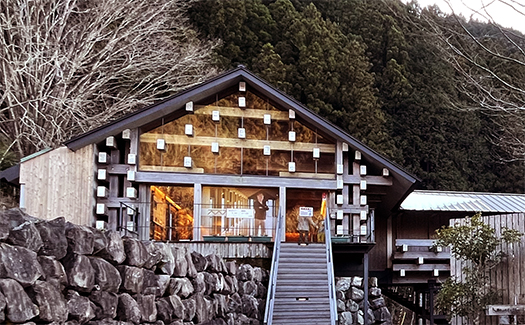
扇の軸がタテにすっくと立ち上がりそれを広げたような外観を見せている木橋側とは対比的に屋根頂部から下側に架構が広がったような架構のアトリエギャラリー。その壁面には斗栱の太い木材が白く塗られて独特の幾何模様を見せている。木材の断面の保護のために塗られた防腐剤とおぼしき顔料が、木橋と呼応しているように思われる。
一方以下の写真は、木橋側の内観。

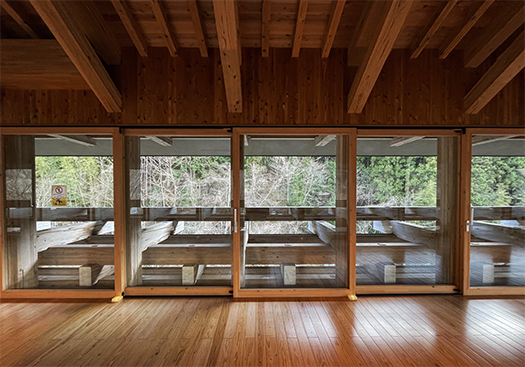
見る者にこのような「木に抱かれる」感覚を味わわせる、そういう空間体験を抱かせることが、梼原という地域としても重要なメッセージになると考えたのではないか。そしてそれは今回わたしにも確かに伝わってきた。
いま、日本全体で公共建築に「木造採用」の動きが非常に強まってきている。東京オリンピック2021で隈研吾設計の国立競技場のデザインが話題になったけれど、それが確かに公共建築木造化のひとつの「号砲」になったものかも知れない。
そのコンセプトの原点がこのような空間体験に込められている。
高知県は森林の面積が全体の8割以上を占める「森林王国」。その中でも、愛媛県との県境にあり、四万十川の源流域に位置する梼原町は森林面積が91%にも上り、地元では森林産業を盛り上げようとこれまで様々な試みが展開されてきたとされる。
こういった文脈の中で、隈研吾建築群がいわばランドスケープデザインとして採用され、その役割を果たしているということなのでしょう。
English version⬇
Yusuhara, Shikoku and Kengo Kuma – 4
The movement to “utilize wood” in public buildings is accelerating across Japan. Kengo Kuma Design is extremely busy (laughs). Is Yusuhara the epicenter of this trend? Yusuhara is the epicenter of this trend.
The explanation of Kengo Kuma’s architecture was written on the on-site panel display at the Mokuhashi Museum, but the expression is a bit difficult to understand.
The entire structure, which overdrives the traditional expression of “tokyo,” or “wooden structure” with its overlapping splintered timbers, is what might be called a “kumi-zukuri zukuri,” or “wooden structure,” and it exudes a sense of presence (concreteness) and abstraction that cannot be achieved with an axial structure.
If it were shown in a photograph, this photograph would be a togue. It is placed at the top of the column or above the shaft to support the eaves girder. It is true that the expression “kumi-zukuri zukuri” is appropriate and that this kind of structure gives the viewer an image different from that of a normal wooden frame structure. In a broader sense, the “tohoku” structure technique is probably best understood as one of the “kumimono” types commonly used in shrine and temple architecture.
〜By bridging various subjects such as “revitalization of local culture,” “urban design,” “erection technology,” and “materials and traditional expression,” Kuma attempted to create a new way of thinking about public architecture. 〜Kengo Kuma explains his design intent in the following postscript: “I wanted to create a new way of thinking about public architecture.
In contrast to the wooden bridge side, which looks as if the shaft of a fan rises up vertically and spreads out, the atelier gallery has a structure that looks as if the structure extends from the top of the roof to the underside. The thick timbers of the tohoku are painted white on the wall surface, showing a unique geometric pattern. The pigment, which appears to be a preservative applied to protect the cross section of the wood, seems to correspond to the wooden bridge.
The following photo is an interior view of the wooden bridge side.
Yusuhara must have thought that giving viewers this kind of “tree hugging” sensation, this kind of spatial experience, would be an important message for the region. And this message was certainly conveyed to me this time.
In Japan today, there is a growing trend toward the use of wooden structures in public buildings. Kengo Kuma’s design of the National Stadium for the Tokyo Olympics 2021 has become the talk of the town, and it may indeed be the signal for the shift to wood construction in public buildings.
The origin of this concept is contained in this kind of spatial experience.
Kochi Prefecture is a “forest kingdom” with more than 80% of its total forest area. Yusuhara, which is located on the border with Ehime Prefecture and at the headwaters of the Shimanto River, has 91% forest area.
It is in this context that Kengo Kuma’s architectural group has been adopted as a landscape design, so to speak, and is playing a role in this context.
Posted on 3月 27th, 2023 by 三木 奎吾
Filed under: 住宅マーケティング, 日本社会・文化研究







コメントを投稿
「※誹謗中傷や、悪意のある書き込み、営利目的などのコメントを防ぐために、投稿された全てのコメントは一時的に保留されますのでご了承ください。」
You must be logged in to post a comment.